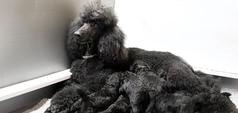
Preparing for Puppies: Stages of Dog Labour

Most breeders hope for an uneventful canine pregnancy that results in a smooth delivery of a healthy, full-sized litter. Recognizing the signs and stages of labour can help avert any problems that could sideline those expectations.
“Intervening early rather than too late is important if labour and delivery are not normal,” says Julie T. Cecere, DVM, MS, DACT, a board-certified veterinary reproduction specialist at Virginia-Maryland College of Veterinary Medicine. “When it comes to doing your best to protect the safety of the bitch and her puppies, you should understand the differences between a normal versus an abnormal whelping and be prepared to act fast if something doesn’t seem right.”
Marty Greer, DVM, JD, who has a special interest in reproduction and is co-owner of Veterinary Village in Lomira, Wisconsin, advises breeders to start preparing for puppies from day one via progesterone testing of the bitch. “Timing is everything,” she says. “Progesterone testing allows you to breed bitches at the optimal time. It also allows you to pinpoint an accurate due date, which is so important if an emergency arises during whelping or if you need to schedule a cesarean section.”
Drawing on 35 years of experience breeding Pembroke Welsh Corgis and Danish-Swedish Farmdogs, Dr. Greer offers valuable advice to help you prepare for the arrival of puppies:
- Include your veterinarian right from the start of the breeding process and make sure you have access to emergency veterinary care in case assistance is needed, even during odd hours.
- A few days before the expected delivery date, give your pregnant dog a gentle bath using a mild shampoo. This helps reduce the presence of microorganisms on her skin and coat.
- Make sure you get enough rest yourself, as you need to be well-prepared to assist the mother dog during the whelping process.
- Have a vehicle ready with a full tank of gas in case of an emergency which requires immediate transportation.
- Be ready to travel with the mother dog and newborn puppies if necessary, ensuring their safety and well-being.
Knowing how to assist when puppies are born during stage II labour is helpful should the bitch not do her job after a couple of minutes, says Purina Senior Research Nutritionist Deb Greco, DVM, PhD, DACVIM, a breeder of Standard Poodles. “After a puppy is delivered, remove the membrane covering, clean the face, and suction mucus from the mouth and nose. Use a clean towel to gently dry and rub the puppy to stimulate its breathing. In a few minutes, the pup will begin to cry loudly,” she says.
Being prepared to have puppies doesn’t mean things won’t go wrong. “If at any time during whelping breeders notice black vulvar discharge, moderate to large amounts of fresh blood or are concerned, they should not hesitate to call their veterinarian,” says Dr. Cecere.
It is crucial for breeders to have a good understanding of normal whelping in order to recognize any potential issues that may arise. While every pregnancy is unique, it is important to be prepared for any unexpected complications during labour and delivery. Being well-prepared will help ensure the best possible outcome for both the mother and the puppies.
Signs & Stages of Labour
| Stage of Labour | What Happens | Signs | Normal | Abnormal: Consult Your Veterinarian |
| Stage I | Preparation of birth indicated by the opening of the cervix | Anorexia, nesting, panting, digging, pacing, and whining
| Signs should begin 24 hours after the rectal temperature drops to or below 36.9 degrees Celsius and can last up to 18 hours
|
|
| Stage II | Active labour involving contractions and pushing | In response to contractions, bitch begins pushing, initiating the onset of Stage II Labour
| First contractions and pushing can last up to one hour prior to the first puppy. Pushing and/or contractions lasting greater than 30 minutes for subsequent puppies is abnormal
|
|
Stage III
| Passage of the placenta | Passage of the placenta | Usually occurs immediately after each pup is whelped but can by delayed by the immediate passage of another puppy
|
|
Purina® Pro Plan® is the #1 brand most fed and recommended brand by dog breeders in Canada.* Learn more about the what the Pro Club Breeder program has to offer, including up to 25% savings on Pro Plan dog and puppy food, a free bag of puppy food for your new pet owners and more!
*Canadian Dog Fancier survey results, November 2023
Related articles


